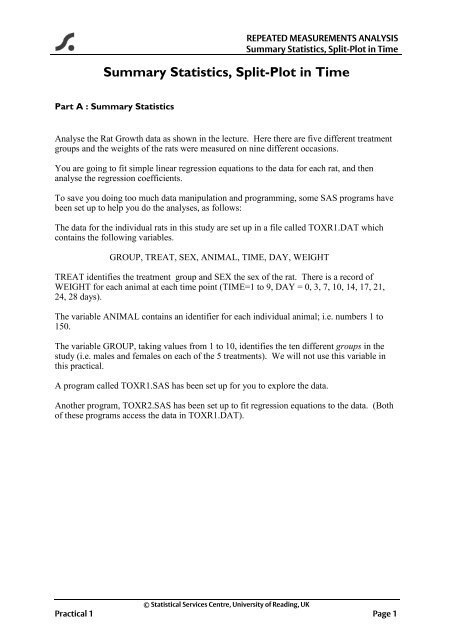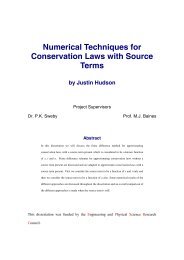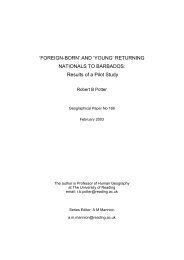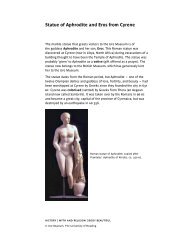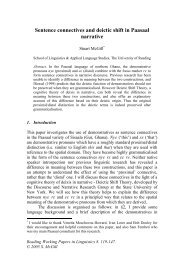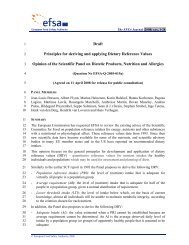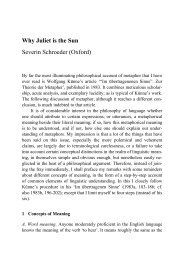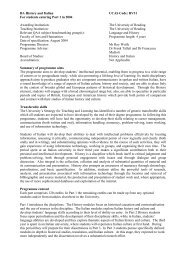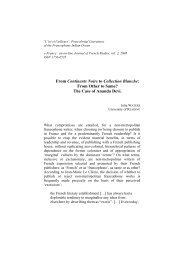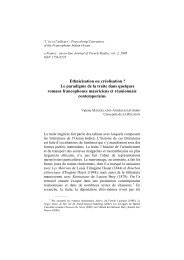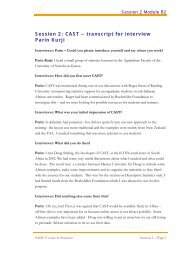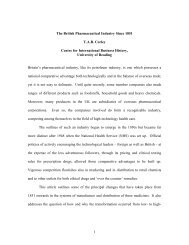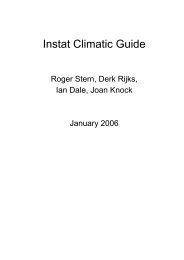Summary Statistics, Split-Plot in Time - University of Reading
Summary Statistics, Split-Plot in Time - University of Reading
Summary Statistics, Split-Plot in Time - University of Reading
Create successful ePaper yourself
Turn your PDF publications into a flip-book with our unique Google optimized e-Paper software.
REPEATED MEASUREMENTS ANALYSIS<br />
<strong>Summary</strong> <strong>Statistics</strong>, <strong>Split</strong>-<strong>Plot</strong> <strong>in</strong> <strong>Time</strong><br />
<strong>Summary</strong> <strong>Statistics</strong>, <strong>Split</strong>-<strong>Plot</strong> <strong>in</strong> <strong>Time</strong><br />
Part A : <strong>Summary</strong> <strong>Statistics</strong><br />
Analyse the Rat Growth data as shown <strong>in</strong> the lecture. Here there are five different treatment<br />
groups and the weights <strong>of</strong> the rats were measured on n<strong>in</strong>e different occasions.<br />
You are go<strong>in</strong>g to fit simple l<strong>in</strong>ear regression equations to the data for each rat, and then<br />
analyse the regression coefficients.<br />
To save you do<strong>in</strong>g too much data manipulation and programm<strong>in</strong>g, some SAS programs have<br />
been set up to help you do the analyses, as follows:<br />
The data for the <strong>in</strong>dividual rats <strong>in</strong> this study are set up <strong>in</strong> a file called TOXR1.DAT which<br />
conta<strong>in</strong>s the follow<strong>in</strong>g variables.<br />
GROUP, TREAT, SEX, ANIMAL, TIME, DAY, WEIGHT<br />
TREAT identifies the treatment group and SEX the sex <strong>of</strong> the rat. There is a record <strong>of</strong><br />
WEIGHT for each animal at each time po<strong>in</strong>t (TIME=1 to 9, DAY = 0, 3, 7, 10, 14, 17, 21,<br />
24, 28 days).<br />
The variable ANIMAL conta<strong>in</strong>s an identifier for each <strong>in</strong>dividual animal; i.e. numbers 1 to<br />
150.<br />
The variable GROUP, tak<strong>in</strong>g values from 1 to 10, identifies the ten different groups <strong>in</strong> the<br />
study (i.e. males and females on each <strong>of</strong> the 5 treatments). We will not use this variable <strong>in</strong><br />
this practical.<br />
A program called TOXR1.SAS has been set up for you to explore the data.<br />
Another program, TOXR2.SAS has been set up to fit regression equations to the data. (Both<br />
<strong>of</strong> these programs access the data <strong>in</strong> TOXR1.DAT).<br />
© Statistical Services Centre, <strong>University</strong> <strong>of</strong> Read<strong>in</strong>g, UK<br />
Practical 1 Page 1
REPEATED MEASUREMENTS ANALYSIS<br />
<strong>Summary</strong> <strong>Statistics</strong>, <strong>Split</strong>-<strong>Plot</strong> <strong>in</strong> <strong>Time</strong><br />
(i) First <strong>of</strong> all, us<strong>in</strong>g TOXR1.SAS, look at the pr<strong>of</strong>iles for the <strong>in</strong>dividual rats.<br />
The code to do this is all set up for you <strong>in</strong> the program. All you have to do is run it.<br />
Do you see any consistent pattern to the <strong>in</strong>dividual rat pr<strong>of</strong>iles?<br />
Do the pr<strong>of</strong>iles seem l<strong>in</strong>ear?<br />
(ii) Now, us<strong>in</strong>g TOXR2.SAS, try fitt<strong>in</strong>g the follow<strong>in</strong>g simple curve to the pr<strong>of</strong>iles:<br />
y = a + bt<br />
where y is weight and t is day; and analyse the coefficient b.<br />
With<strong>in</strong> the program TOXR2.SAS the curve is fitted for each rat us<strong>in</strong>g PROC REG,<br />
and the coefficients are saved <strong>in</strong>to temporary datasets called BETA and then<br />
TOX_REG. Make sure you understand what the SAS commands are do<strong>in</strong>g here.<br />
Please ask if you are unsure.<br />
Then use the dataset TOX_REG to analyse the coefficients. Look first <strong>of</strong> all at effects<br />
due to sex, treatment and the sex*treatment <strong>in</strong>teraction, e.g.<br />
PROC GLM DATA = TOX_REG;<br />
CLASS SEX TREAT;<br />
MODEL DAY = SEX TREAT SEX*TREAT/SS2;<br />
LSMEANS SEX TREAT SEX*TREAT;<br />
RUN;<br />
(iii) The five treatments <strong>in</strong> this experiment (numbered 1 to 5) were respectively: control,<br />
compound A at 4, 20 and 100mg/kg/day and compound B at 100mg/kg/day. The<br />
overall treatment effect can be broken down <strong>in</strong>to treatment contrasts. Four contrasts<br />
have been set up with<strong>in</strong> the program for you to use. Make sure you are clear which<br />
comparisons they relate to. Now analyse the data aga<strong>in</strong>, <strong>in</strong>corporat<strong>in</strong>g these contrasts.<br />
What do you conclude?<br />
© Statistical Services Centre, <strong>University</strong> <strong>of</strong> Read<strong>in</strong>g, UK<br />
Practical 1 Page 2
Part B : <strong>Split</strong>-<strong>Plot</strong> <strong>in</strong> <strong>Time</strong><br />
Question 1<br />
REPEATED MEASUREMENTS ANALYSIS<br />
<strong>Summary</strong> <strong>Statistics</strong>, <strong>Split</strong>-<strong>Plot</strong> <strong>in</strong> <strong>Time</strong><br />
Cardiac Enzyme Data. This is the experiment look<strong>in</strong>g at the effects <strong>of</strong> preserv<strong>in</strong>g liquids on<br />
the enzyme content <strong>of</strong> dog hearts. The ATP levels for the 23 dog hearts, recorded dur<strong>in</strong>g a 12<br />
hour period may be found <strong>in</strong> the file CARDENZ1.DAT. This file conta<strong>in</strong>s the follow<strong>in</strong>g<br />
variables:<br />
HEART, A, B, ATP_0, ATP_1, ATP_2 to ATP_9<br />
The two variables A and B are factors each at two levels, and it is the comb<strong>in</strong>ation <strong>of</strong> these<br />
two which constitutes the four preserv<strong>in</strong>g liquids which were studied <strong>in</strong> the experiment.<br />
ATP_0 conta<strong>in</strong>s the basel<strong>in</strong>e ATP value whilst ATP_1 to ATP_9 conta<strong>in</strong> the values<br />
follow<strong>in</strong>g <strong>in</strong>itial preservation.<br />
A program called CARDENZ1.SAS has been set up for you to read <strong>in</strong> and analyse these data.<br />
Us<strong>in</strong>g CARDENZ1.SAS carry out a split-plot-<strong>in</strong>-time analysis <strong>of</strong> variance on these data.<br />
You will need PROC GLM with the REPEATED statement, as follows.<br />
PROC GLM;<br />
CLASS A B;<br />
MODEL ATP_1-ATP_9 = A B A*B/SS2;<br />
REPEATED TIME 9;<br />
RUN;<br />
The above will give you a separate analysis <strong>of</strong> variance for the data at each time po<strong>in</strong>t, as<br />
well as the split plot <strong>in</strong> time analysis. Record below the residual mean squares from the<br />
analyses <strong>of</strong> each time po<strong>in</strong>t.<br />
ATP_1<br />
ATP_2<br />
ATP_3<br />
ATP_4<br />
ATP_5<br />
ATP_6<br />
ATP_7<br />
ATP_8<br />
ATP_9<br />
Residual Mean Square<br />
Does the variance appear to be constant across time?<br />
Try out some <strong>of</strong> the different options which are available on the MODEL and REPEATED<br />
statements.<br />
© Statistical Services Centre, <strong>University</strong> <strong>of</strong> Read<strong>in</strong>g, UK<br />
Practical 1 Page 3
e.g. on the MODEL statement<br />
REPEATED MEASUREMENTS ANALYSIS<br />
<strong>Summary</strong> <strong>Statistics</strong>, <strong>Split</strong>-<strong>Plot</strong> <strong>in</strong> <strong>Time</strong><br />
/NOUNI will suppress all the analyses at the <strong>in</strong>dividual time po<strong>in</strong>ts<br />
on the REPEATED statement<br />
/NOM will suppress any multivariate analyses<br />
/PRINTE will give the partial correlation coefficients for the <strong>in</strong>dividual time<br />
po<strong>in</strong>ts, and sphericity tests. The sphericity test for the orthogonal components is the<br />
test for the type H structure.<br />
What do the results <strong>of</strong> the analysis show you?<br />
What are the Greenhouse-Geisser and Huynh-Feldt estimates <strong>of</strong> ε( εɵ ~<br />
ε)<br />
and ?<br />
And how is the significance <strong>of</strong> the <strong>in</strong>teractions with time modified by us<strong>in</strong>g these two<br />
adjustments to the degrees <strong>of</strong> freedom <strong>in</strong> the F-test.<br />
What was the result <strong>of</strong> the Chi-square test for the type H structure? And how do you <strong>in</strong>terpret<br />
it?<br />
Make sure your output agrees with the results <strong>in</strong> the lecture.<br />
© Statistical Services Centre, <strong>University</strong> <strong>of</strong> Read<strong>in</strong>g, UK<br />
Practical 1 Page 4
Question 2<br />
REPEATED MEASUREMENTS ANALYSIS<br />
<strong>Summary</strong> <strong>Statistics</strong>, <strong>Split</strong>-<strong>Plot</strong> <strong>in</strong> <strong>Time</strong><br />
Carry out a split-plot-<strong>in</strong>-time anova us<strong>in</strong>g the Rat Growth data. You will now use the dataset<br />
called TOXR2.DAT, which conta<strong>in</strong>s the variables TREAT, SEX, ANIMAL and Y0 to Y8,<br />
where Y0 to Y8 conta<strong>in</strong> the weights recorded at the n<strong>in</strong>e times.<br />
A program called TOXR3.SAS which accesses TOXR2.DAT has been set up for you to use<br />
for this analysis.<br />
(i) Investigate the data on rat weights, <strong>in</strong>itially us<strong>in</strong>g the factors sex and group (and their<br />
<strong>in</strong>teraction). Aga<strong>in</strong> you will need to use PROC GLM with a REPEATED statement.<br />
From the univariate analyses <strong>of</strong> the data at each time po<strong>in</strong>t, does it appear that the<br />
variance <strong>of</strong> rat weight is constant over time? And what can you conclude from the<br />
correlation matrix <strong>of</strong> the weights at the different time po<strong>in</strong>ts?<br />
Do the data therefore suggest that the repeated measurements have a uniform<br />
covariance structure? Are your conclusions verified by the test for the type H<br />
structure?<br />
What are the values for εɵ and εɶ<br />
for these data? And how does modify<strong>in</strong>g the analysis<br />
by us<strong>in</strong>g the adjusted degrees <strong>of</strong> freedom <strong>in</strong> each case affect your <strong>in</strong>terpretation <strong>of</strong> the<br />
<strong>in</strong>teractions <strong>of</strong> sex and group with time.<br />
(ii) If you have time, you could try the analysis us<strong>in</strong>g the four treatment contrasts which<br />
have been specified <strong>in</strong> the program. Which contrasts result <strong>in</strong> significant effects and<br />
<strong>in</strong>teractions, and how can you <strong>in</strong>terpret the results?<br />
© Statistical Services Centre, <strong>University</strong> <strong>of</strong> Read<strong>in</strong>g, UK<br />
Practical 1 Page 5


